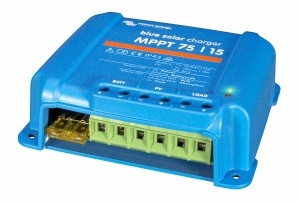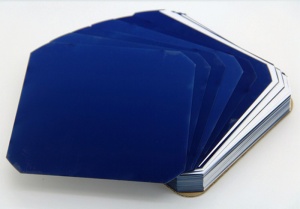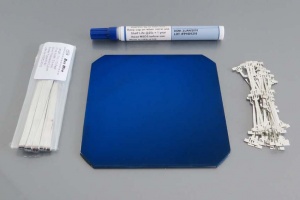Solar Panel Charging: Difference between revisions
| Line 76: | Line 76: | ||
-> Equipment | -> Equipment | ||
== Circuit breakers == | == Circuit breakers/fuses == | ||
An important part of a safe solar installation are circuit breakers. They are installed in between major modules in the system, e.g. solar array and controller, battery and controller, and battery and inverter. | An important part of a safe solar installation are circuit breakers and fuses. They are installed in between major modules in the system, e.g. solar array and controller, battery and controller, and battery and inverter. | ||
Revision as of 17:27, 5 June 2016
Basics about solar panel battery charging.
Panels
Monocrystalline panels are regarded as being the most efficient panel technology. Second to Polycrystalline panels. In, 2016, Sunpower is considered to have the best solar cell technology, they are also used on the Solar Impulse aeroplane.
Common configurations of individual panels:
- 100W - common
- 120W
- 150W - common
- 160W
- 300W
Arrays are usually build by parallel installation of multiple of the same panel type, e.g. 10x150W panels is a 1500W or 1.5kW array.
Some cheap flexible panels:
- 100W 18V Mono panel - 137USD
Solar controllers
There are two kinds of controllers; MPPT and PWM charging mode, with the former being the preferred one on larger (>50W) setups.
A reasonable decent solar controller starts at 50USD, for a 10 to 30A 12V setup. A 30A controller can handle up to 30 x 12 = 360W of solar panels connected to the input.
- Solar controller 30A 12V - 44USD
Batteries
Using regular 12V or 24V batteries makes it simple to get set up. It is preferred to use deep cycle branded batteries because these are have thicker plates and are designed relatively low continuous power draw.
- AGM (Absorbed Glass Mat) 12V lead acid battery - recommended type for solar, can hold 300 cycles when kept above 50% discharge rate
- Gel cell 12V lead acid battery - suitable for very deep cycle operations and hot environments [1]
Building solar panels
It is possible to build a large solar panel from scratch. You only need to get the individual parts, which is really not that much or hard to put together.
Kits:
- DIY 100W Sunpower Maxeon C60 Solar Panel 21.8% Efficiency - 32pcs x 3.34W
- Sunpower Maxeon C60 Solar Cell 10pcs with 10pcs dog bone wires
Different parts of the system:
- Solar Cell - photovoltaic module, converts sunlight to electric current, provides approx. 0.5V each
- Typical cells: 6x6-inches at 4.8W, 5x5-inches at 3.2W
- Solar Tabbing Wire - connects modules into strings - multiple cells connected together, e.g. 9 cells provides 4.5V (0.5V x 9)
- Bus Wire - forms an "S"-shape and connects the strings into an panel, e.g. 4 strings provides 18V (4.5V x 4)
- Flux Pen - makes it easier to solder the tabbing and bus wire
- Encapsulation Film - seals the front and back of the solar cells in a vacuum
- Backing Sheet - works as an insulator and protects the back of the panel, usually a multilayer laminate
- Mounting Frame - makes it easier to mount the panel to a roof or other installation infrastructure
- Junction Box - connects the two bus ends to screw terminals
- Cable - makes it easier to weatherproof and connect multiple panels together, e.g. in series (higher voltage) or parallel (more current)
- Diode - when panels are installed in parallel and one is damaged, a bypass diode allows the other panels to still work, also blocks reverse current flow, installed in the junction box
Inverter
If there is any equipment or appliances that require 110/220V AC power, an inverter will convert 12V DC to AC power you need. The main parameter that dictates the kind of inverter you need is the wattage rating, e.g. a MacBook charger is 85W and then you require a 100W or better inverter to power it properly.
The second parameter to consider is operation mode, if it is going to supply power back to the power grid, called grid tied (requires certified installation), or a simpler independent car type inverter.
- Inverter 110/220V 100 to 3000W car or grid tied
For optimum efficiency (minimized power loss in conversion), always try to power or adapter the equipment from DC directly. The chain of the energy flow is as follows:
Solar array -> Charger controller -> Battery -> Inverter -> Equipment
-> Equipment
Circuit breakers/fuses
An important part of a safe solar installation are circuit breakers and fuses. They are installed in between major modules in the system, e.g. solar array and controller, battery and controller, and battery and inverter.



